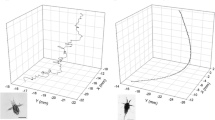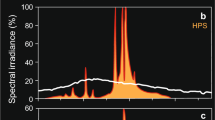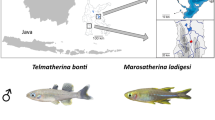Abstract
Visual predation by fish on copepods involves prey encounter, attack and capture; during any of these processes prey selection can occur. Developmental changes in copepods, including increases in swimming speed, size and image contrast increase the encounter rate and distance at which they can be detected by predators. Copepods compensate for this increase vulnerability with age through diel vertical migration and improved escape capabilities. This study quantifies the changes in swimming speed and movement pattern with developmental stage of the copepod Acartia tonsa, using a video-computer system for motion analysis. Changes in visible size and image contrast with developmental stage were quantified under simulated natural illumination conditions using a video based image analysis system. The escape responses of the naupliar stages of the copepod Acartia tonsa were quantified in response to a stationary pipette sucking in water at a constant speed. Accurate quantification of the parameters that affect feeding selectivity of planktivorous fish will provide the basis for evaluation of their relative importance in future studies.
Similar content being viewed by others

References
Brooks, J.L. & S.I. Dodson, 1965. Predation, body size, and composition of plankton. Science 150: 28–35.
Buskey, E.J., C. Coulter & S. Strom, 1993. Locomotory pattern of microzooplankton: potential effects on food selectivity of larval fish. Bull. mar. Sci. 53: 29–43.
Checkley, D.M. 1982. Selective feeding by Atlantic herring (Clupea harengus) larvae on zooplankton in natural assemblages. Mar. Ecol. Prog. Ser. 9: 245–253.
Confer, J.L., G.L. Howick, M.H. Corzette, S.L. Kramer, S. Fitzgibbon & R. Landesberg, 1978. Visual predation by planktivores. Oikos 31: 27–37.
Drenner, R.W. & S.R. McComas, 1980. The roles of zooplankton escape ability and fish size selectivity in the selective feeding and impact of planktivorous fish. In W.C. Kerfoot (ed.), Evolution and ecology of zooplankton communities. University Press of New England, Hanover, New Hampshire: 587–593.
Drenner, R.W., J.R. Strickler & W.J. O'Brien, 1978. Capture probability: the role of zooplankton escape in the feeding of planktivorous fish. J. Fish. Res. Bd Can. 35: 1370–1373.
Eggers, D.M., 1977. The nature of prey selection by planktivorous fish. Ecology 58: 46–59.
Gerritsen, J., 1978. Instar-specific swimming patterns and predation of planktonic copepods. Verh. int. Ver. Limnol. 20: 2531–2536.
Gerritsen, J. & J.R. Strickler, 1977. Encounter probabilities and community structure in zooplankton: a mathematical model. J. Fish. Res. Bd Can. 34: 73–82.
Govoni, J.J., P.B. Ortner, R. Al-Yamani & L.C. Hill, 1986. Selective feeding of spot, Leiostomus xanthurus, and Atlantic croaker, Micropogonias undulatus, larvae in the northern Gulf of Mexico. Mar. Ecol. Prog. Ser. 28: 175–183.
Greze, V.N., 1963. The determination of transparency among planktonic organisms and its protective significance. Doklady Akademii Nauk SSSR Biological Science Section (English Translation) 15: 956–958.
Hall, D.J., S.T. Threlkeld, C.W. Burns & P.H. Crowley, 1976. The size efficiency hypothesis and the structure of zooplankton communities. Ann. Rev. ecol. Syst. 7: 177–208.
Haury, L.R., D.E. Kenyon & J.R. Brooks, 1980. Experimental evaluation of the avoidance reaction of Calanus finmarchicus. J. Plankton Res. 2: 187–202.
Hinshaw, J.M., 1985. Effects of illumination and prey contrast on survival and growth of larval yellow perch Perca flavescens. Trans. am. fish. Soc. 114: 540–545.
Holling, C.S., 1959. The components of predation as revealed by a study of small mammal predation of European pine sawfly. Can. Ent. 91: 293–320.
Hunter, J.R., 1981. Feeding ecology and predation of marine fish larvae, In R. Lasker (ed.), Marine fish larvae: morphology, ecology and relation to fisheries. Wash. Sea Grant Prog., Univ. Wash. Press, Seattle: 33–77.
Kerfoot, W.C., 1980. Commentary: transparency, body size, and prey conspicuousness. In W.C. Kerfoot (ed.), Evolution and ecology of zooplankton communities. University Press of New England, Hanover, New Hampshire: 609–617.
Kerfoot, W.C., 1982. A question of taste: crypsis and warning coloration in freshwater zooplankton communities. Ecology 63: 538–554.
O'Brien, W.J., N.A. Slade & G.L. Vinyard, 1976. Apparent size as the determinant of prey selection by bluegill sunfish (Lepomis macrochinus). Ecology 57: 1304–1310.
Partridge, J.C., 1990. The colour sensitivity and vision of fishes. In P.J. Herring, A.K. Campbell, M. Whitfield & L. Maddock (eds), Light and life in the sea. Cambridge University Press, Cambridge: 167–184.
Singarajah, K.V., 1969. Escape reactions of zooplankton: the avoidance of a pursuing siphon tube. J. exp. mar. Biol. Ecol. 3: 171–178.
Stich, H.-B. & W. Lampert, 1981. Predator evasion as an explanation of diel vertical migration of zooplankton. Nature 293: 396–398.
Vinyard, G.L. & W.J. O'Brien, 1976. Effects of light and turbidity on the reactive distance of bluegill (Lepomis macrochirus). J. Fish. Res. Bd Can. 33: 2845–2849.
Ware, D.M., 1973. Risk of epibenthic prey to predation by rainbow trout (Salmo gairdneri). J. Fish. Res. Bd Can. 30: 787–797.
Wright, D.I. & W.J. O'Brien, 1982. Differential location of Chaoborus larvae and Daphnia by fish: the importance of motion and visible size. Amer. Midl. Nat. 108:68–73.
Zaret, T.M., 1972. Predators, invisible prey, and the nature of polymorphism in the Cladocera (Class Crustacea). Limnol. Oceanogr. 17: 171–184.
Zaret, T.M. & W.C. Kerfoot, 1975. Fish predation on Bosmina longirostris: body size selection versus visibility selection. Ecology 56: 232–237.
Zaret, T. & J.S. Suffern 1976. Vertical migration in zooplankton as a predator avoidance mechanism. Limnol. Oceanogr. 21: 804–813.
Author information
Authors and Affiliations
Rights and permissions
About this article
Cite this article
Buskey, E.J. Factors affecting feeding selectivity of visual predators on the copepod Acartia tonsa: locomotion, visibility and escape responses. Hydrobiologia 292, 447–453 (1994). https://doi.org/10.1007/BF00229971
Issue Date:
DOI: https://doi.org/10.1007/BF00229971



